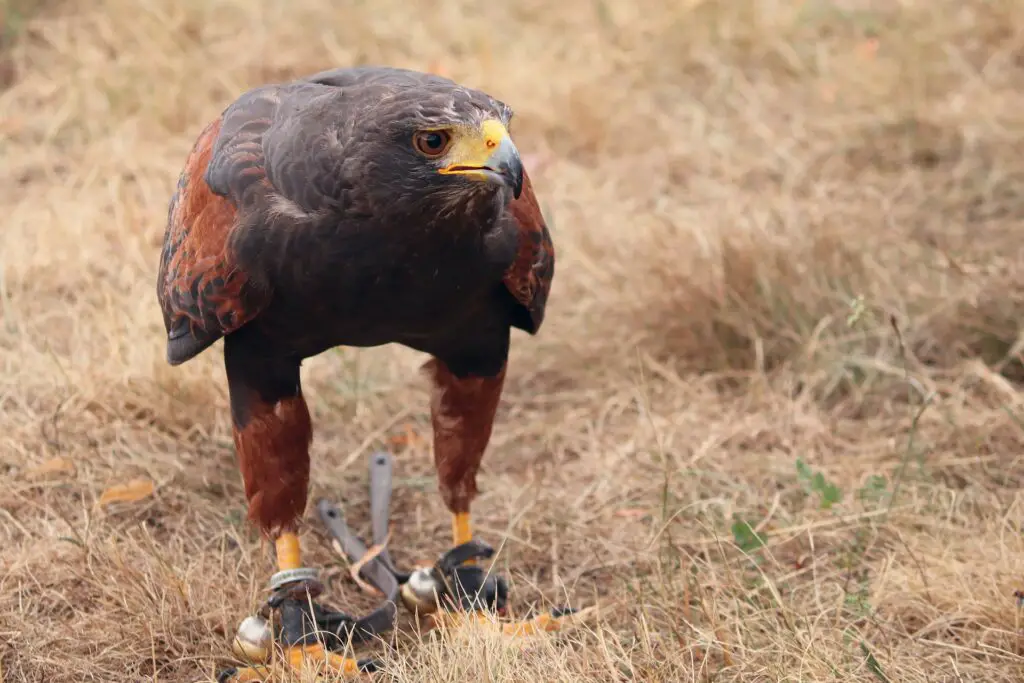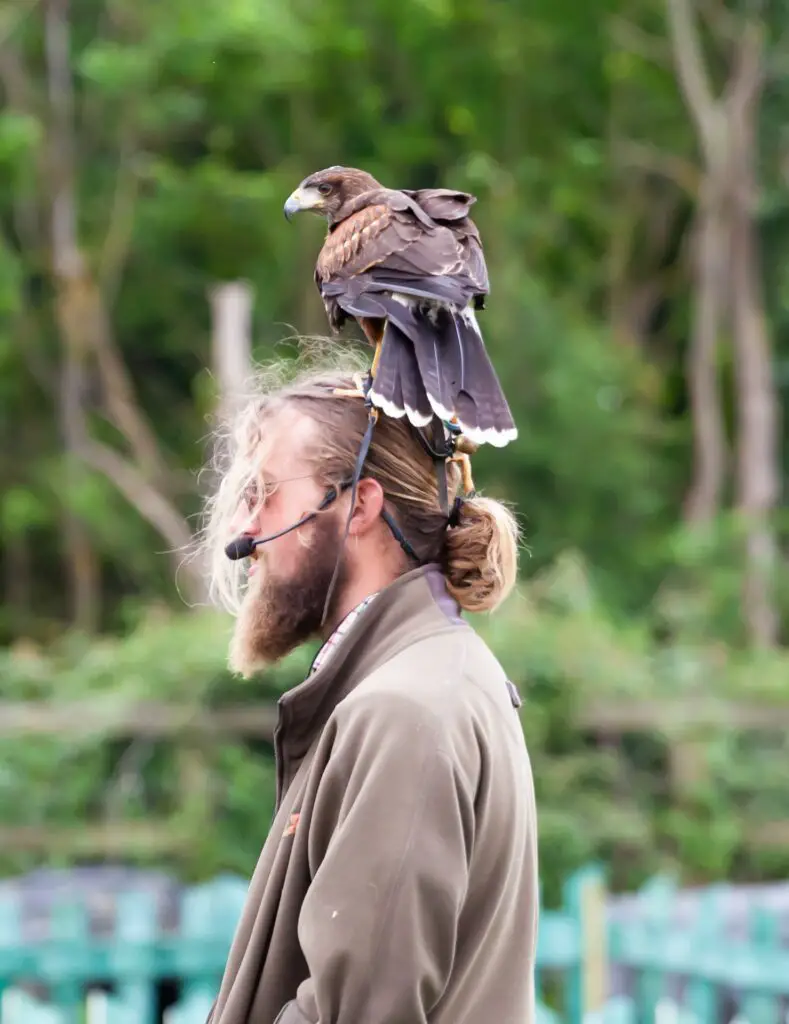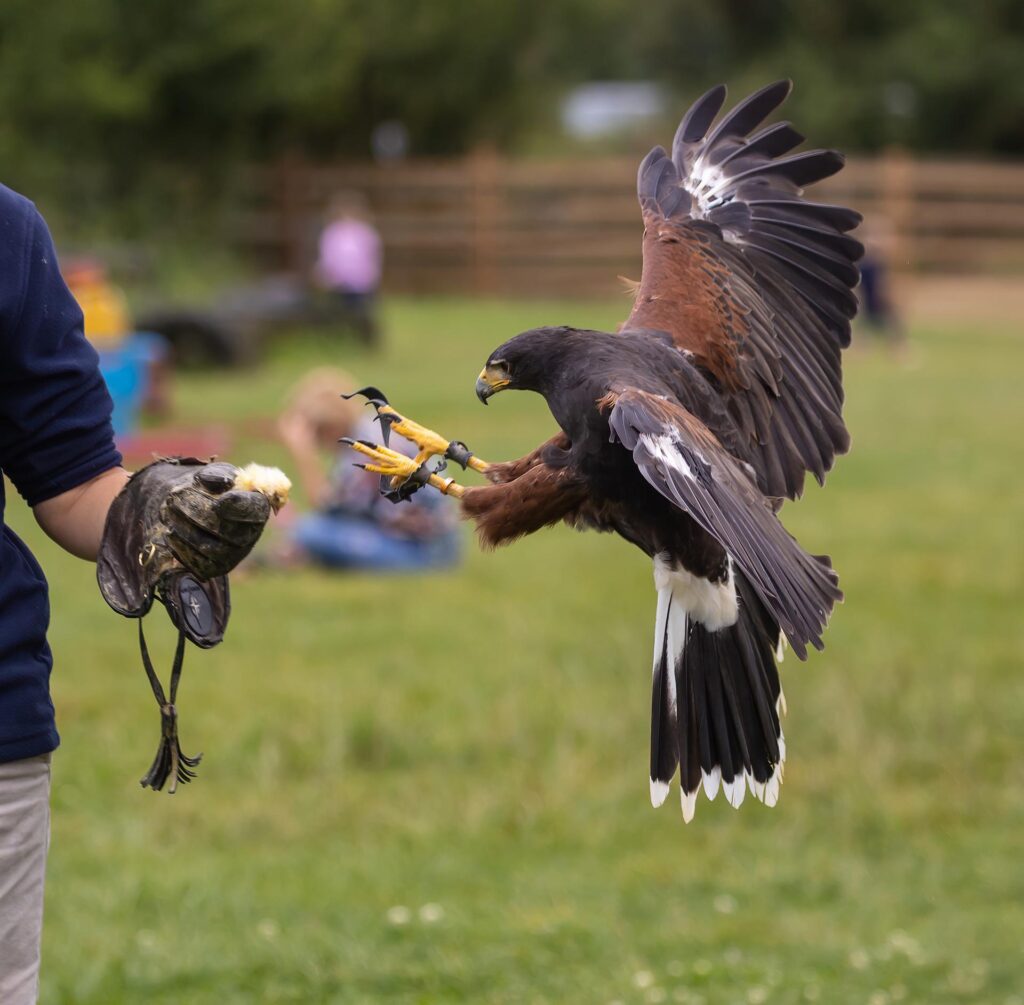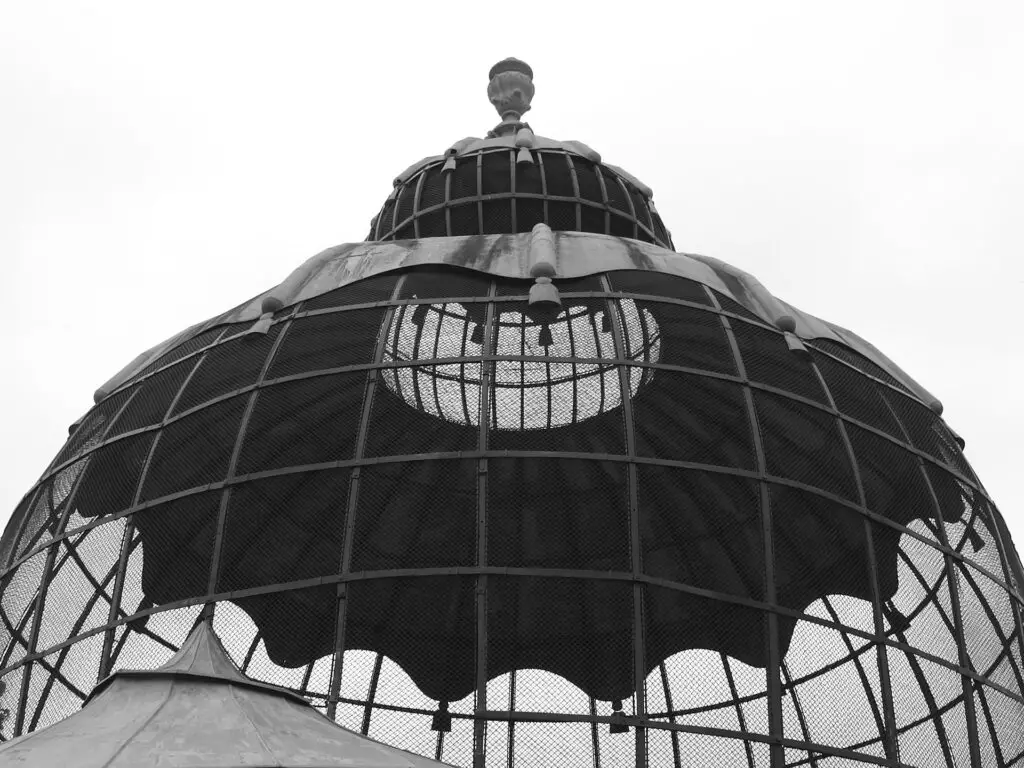Setting up a mew for my Harris Hawk was a fun time for me, and with careful planning and attention to detail, it can be a rewarding experience. Organizing the space to cater to the needs of a raptor like a Harris hawk requires thoughtful consideration. From the layout of the mew to the types of perches and enrichment activities provided, every aspect plays an essential role in ensuring the bird’s well-being and comfort. Let me share with you how I did it, with it all laid out below.
Mews
When setting up my mew for a Harris Hawk, I meticulously planned the design to ensure the hawk’s welfare and happiness. Opting for a spacious and secure enclosure, I chose robust materials like pressure-treated wood and galvanized steel mesh for durability and safety. The mew was carefully crafted to provide ample room for the hawk to move around freely and easily exercise its wings.

Considering the hawk’s comfort, I included perches at varying heights to promote natural roosting behavior and prevent foot issues. Size was a crucial factor. Hence, the mew’s dimensions of 3.05m x 3.05m x 2.44m (10ft x 10ft x 8ft) were selected to comfortably accommodate the hawk’s wingspan. Predator protection was a top priority, leading to the reinforcement of the mew with a secure roof and buried wire mesh to deter potential threats.
To maintain a healthy environment, regular cleaning of the mew was prioritized to prevent the buildup of droppings and debris. This attention to detail aimed to create a safe haven where my Harris Hawk could feel secure and content, emphasizing both comfort and security for its overall well-being. Here are a few other factors to consider:
Location and Size
- Choose a quiet and secluded location for the mew, away from disturbances and potential predators. A peaceful environment will help reduce the hawk’s stress.
- The mew should be spacious enough to allow the hawk to move around comfortably, stretch its wings, and exercise. A size of at least 8 feet by 8 feet is recommended for a Harris hawk.
Perches
- Install multiple perches of varying diameters and textures within the mew. This mimics the hawk’s natural environment and allows it to exercise its feet and legs.
- Place the perches at different heights to encourage the hawk to fly short distances within the mew, promoting physical activity and preventing muscle atrophy.
Ventilation and Lighting
- Ensure adequate ventilation within the mew to maintain fresh air circulation and regulate temperature. This can be achieved through adjustable vents or windows that allow for airflow without creating drafts.
- Natural light is essential for the hawk’s well-being. Position the mew so that it receives ample sunlight during the day, or consider installing full-spectrum lighting to simulate natural daylight if direct sunlight is limited.
Roosting Area
- Create a designated roosting area within the mew where the Harris hawk can rest undisturbed. This area should be elevated and lined with soft, non-abrasive materials such as straw or wood shavings to provide comfort and insulation.

Feeding and Watering Stations
- Set up feeding and watering stations within the mew, ensuring easy access for the hawk. Use secure food and water dishes to prevent spillage and contamination, and clean and refill them regularly to maintain hygiene.
By following these guidelines, you can create a safe, comfortable, and stimulating environment for your Harris hawk within its mew. Remember to monitor the hawk’s behavior and well-being regularly and make adjustments to the setup as needed to ensure its health and happiness.
Perches
As I focused on creating a safe and comfortable environment for my Harris Hawk in the new, selecting and placing various types of perches played an important role in promoting its well-being and natural behaviors. Natural branches provide a sense of authenticity, allowing the hawk to perch as it would in the wild. Portable stands offer flexibility, enabling me to move the perches around to keep the environment stimulating. Rope perches help maintain the hawk’s feet’ health by providing varying textures and diameters to grip. Elevated platforms serve as vantage points, satisfying the hawk’s natural instincts to observe its surroundings from a height. Additionally, padded perches offer comfort during rest periods, reducing strain on the hawk’s feet. By incorporating these different types of perches, I aim to provide my Harris Hawk with a diverse and enriching environment that supports its physical and mental well-being.
Roofs
Crafting a sturdy and protective roof for the mew involves utilizing durable materials such as weather-resistant wood or metal, making sure the hawk’s shelter is secure and shielded from the elements. When setting up a mew for a Harris Hawk, the roof plays an important role in providing a safe and comfortable environment for the bird. Here are essential considerations for the roof:
- Roof Materials: Opt for weather-resistant wood or metal to withstand varying conditions and guarantee longevity.
- Shading Options: Use a shading cloth to regulate temperature and protect the hawk from excessive sunlight.
- Creeping Plants: Consider planting creeping plants on the roof to provide natural shading and create a more aesthetically pleasing environment for the hawk.
- Insulation Methods: Implement proper insulation techniques to maintain a comfortable temperature inside the mew during different seasons.
- Waterproofing Techniques: Apply waterproofing sealants or materials to prevent leaks and protect the hawk from moisture-related issues.
Flooring
The flooring of a mew must be carefully selected to guarantee the bird’s comfort and safety. Various factors must be considered when considering flooring options. Common types include concrete, gravel, and wood chips. Concrete is durable and easy to clean but may be hard on the hawk’s feet. Gravel provides good drainage but can be challenging to walk on. Wood chips offer cushioning but may require frequent replacement.
For maintenance, regular cleaning and disinfecting are imperative to prevent bacteria buildup. Concrete floors are easier to clean, while gravel and wood chips need more frequent attention. When comparing durability, concrete outlasts gravel and wood chips, which can deteriorate faster over time. Costs vary, with concrete being more expensive upfront but potentially more cost-effective in the long term due to its longevity.
For eco-friendly new flooring, options like recycled rubber or natural grass are worth considering. These choices focus on sustainability and comfort for the raptor. The selected flooring should prioritize the bird’s well-being while considering practicality and environmental impact.

Ventilation
Ensuring proper ventilation in a mew for a Harris Hawk is essential for maintaining a healthy environment conducive to the bird’s well-being and comfort. When setting up ventilation in the mew, there are key factors to take into account:
- Ventilation Design: Strategically plan the layout to allow for proper air circulation throughout the mew.
- Airflow Management: Balance fresh air coming in and stale air being pushed out.
- Climate Control: Monitor the temperature and humidity levels to create a comfortable environment for the Harris Hawk.
- Wind Protection and Shade Provision: Create areas within the mew where the bird can seek shelter from strong winds and direct sunlight, especially during bad weather. s
Temperature control
Strategically maintaining the temperature within the mew is important for ensuring the comfort and well-being of my raptors. When considering heating options, I prefer using a combination of radiant heat panels and ceramic heat emitters. These methods provide a gentle and consistent warmth, mimicking the natural conditions the Harris Hawk would experience in the wild.
I utilize a fan system for cooling techniques to ensure proper air circulation within the mew. This helps prevent overheating during hot weather, keeping the environment comfortable for my hawk. Humidity control is also essential, and I achieve this by incorporating a dehumidifier to maintain the best moisture levels.
Insulation methods play a key role in temperature regulation. I have insulated the walls and ceiling of the mew to trap heat during colder months and keep the space cool in the summer. Regular temperature monitoring is important, and I use digital thermometers to track and promptly make necessary adjustments. I carefully manage temperature and create a safe and cozy environment for my Harris Hawk.
Nesting area
Implementing a cozy nesting area for my Harris Hawk involves carefully selecting suitable materials and strategically arranging them to provide optimum comfort and security. When setting up the nesting area, I consider the following key elements:
- Nesting materials: I gather soft materials like straw, dried leaves, and feathers to line the nest, ensuring a warm and comfortable environment for my hawk.
- Nest box: I provide a sturdy nest box that mimics the natural cavities hawks prefer for nesting, ensuring it is spacious enough for the hawk to move comfortably.
- Nesting behavior: Understanding my hawk’s nesting behavior helps me create an environment that aligns with its natural instincts, promoting a sense of security and well-being.
- Nest site selection: I carefully choose a secluded and elevated spot within the mew that mimics the hawk’s natural habitat, providing a sense of safety and privacy during the nesting season.
Feeding Area
Creating an easily accessible feeding area for my Harris Hawk was imperative for promoting a healthy and efficient feeding routine. Here’s how I set up the feeding spot:
- Location Selection: The feeding area is strategically placed at a moderate height within the new, easily accessible to both the hawk and myself. This mimics the hawk’s natural preference for elevated dining spots, enhancing its comfort and security during feeding times.
- Layout and safety: To ensure durability and safety, we constructed a simple, sturdy platform made from non-toxic, weather-resistant materials. The edges are smoothed to prevent injury to the bird.
- Ease of Cleaning: Given the importance of hygiene, the feeding platform is designed to be easy to clean and disinfect. It has a removable tray where food can be placed, which can be easily slid out for cleaning after every feeding session, minimizing the risk of bacterial buildup.
- Protection from Elements: A partial canopy is installed over the feeding area to shield the food from adverse weather conditions. This ensures the food remains dry and clean, providing a more appetizing meal for my hawk.
- Observation Point: I also included a discreet viewing area nearby, allowing me to observe the hawk during its feeding without causing any disturbance. This helps in monitoring its eating habits and overall health closely.

Security
Ensuring the security of my mew is paramount to safeguarding the well-being of my Harris Hawk. Here are the key security measures I’ve implemented to protect my hawk:
- Perimeter Fencing: Constructing a sturdy perimeter fence around the mew is the first line of defense against intruders and predators. It guarantees that my Harris Hawk is safe and protected within its designated area.
- Alarm System: Installing an alarm system provides an additional layer of security. It alerts me immediately in case of any unauthorized access or disturbances around the mew, allowing me to respond promptly.
- Surveillance Cameras: Strategically placing surveillance cameras in and around the mew enables me to monitor the hawk even when I’m not physically present. This constant surveillance ensures that any unusual activity is detected and addressed promptly.
- Motion Sensors: Motion sensors are essential for detecting movement around the outside of the mew. They trigger alerts if there is any unexpected activity, helping me stay vigilant and guarantee the hawk’s safety around the clock.
Cleaning
Maintaining a spotless environment inside the mew is important for the health and well-being of my Harris Hawk. Sanitation practices are fundamental in preventing diseases and ensuring a hygienic living space for my bird. I adhere to a strict cleaning schedule to ensure the mew remains clean and safe. Weekly deep cleanings involve removing all bedding, scrubbing perches, and disinfecting surfaces with avian-safe solutions. Disinfectant use is carefully monitored to avoid any harmful residues that could endanger my hawk. Additionally, I prioritize pest prevention by regularly inspecting for signs of infestation and taking immediate action if needed. Proper waste disposal is imperative to prevent the accumulation of waste materials that can attract pests and compromise the hawk’s health. By diligently following these cleaning practices, I provide my Harris Hawk with a clean and healthy environment that promotes its overall well-being and is crucial for its vitality.
Enrichment
Implementing diverse, stimulating activities is essential for enhancing the mental and physical well-being of my Harris Hawk in the mew. When it comes to enrichment, I prioritize the following strategies:
- Behavioral enrichment: I guarantee my Harris Hawk engages in activities that mimic its natural behaviors, such as providing opportunities for hunting or foraging.
- Mental Stimulation: To keep my hawk’s mind active, I incorporate puzzle feeders, training sessions, and interactive toys that challenge its cognitive abilities.
- Environmental enrichment: I create a dynamic environment by adding perches of varying heights, natural branches for grip strength exercises, and hiding spots for mental stimulation.
- Enrichment Activities: Regular flying exercises, agility courses, and sensory experiences like different textures under its feet contribute to a well-rounded enrichment program.
Setting up a mew for my Harris hawk has been a fulfilling experience. From designing the perches to ensuring proper ventilation, every detail has been carefully considered to provide my bird with a safe and enriching environment. I take pride in creating a space that meets all of my hawk’s needs, and I look forward to seeing them thrive in their new home.

